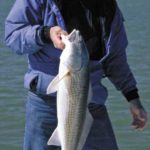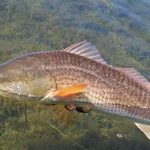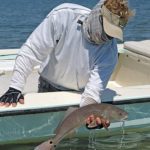
Indian summer and clear water combine for smoking redfish action near Charleston.
We could see dozens of broad-shouldered, copper-plated fish zipping frantically past our hull in the transparent salt creek. Dolphins had surfaced a few hundred yards away, and combined with the sight of our shadowy, out-of-place flats boat, that had the redfish worked up into a panic. For the reds, the clear water was a two-edged sword: easier to spot prey, easier to become prey.The weather was warm for late February, and we’d shed jackets and rolled up sleeves. But we come prepared for anything; you can never predict the winter weather around Charleston. It could be pushing 80 and threatening sunburn or hovering around freezing with a brisk northwest wind slapping you with sleet. Weather-wise, we’d lucked out.
Capt. Ben Alderman had been hauling my family — sons Dan and Sam, and grandson, Jonathon, and me — around the creeks near Isle of Palms for two hours in search of hungry reds. We’d had a few opportunities to cast a couple of plastic grubs, but had only half-hearted hits. And being Upstaters who fish for spot-tails only once or twice a year, the re-learning curve on casting and hook-setting was a steep one.
Finally, Dan cast to the grass’s edge and began a slow, twitching retrieve. Almost immediately, he set the hook on a young, energetic red. Once it was on for sure, he handed the rod to 7-year-old Jonathon. Wide-eyed and holding the thumping rod for dear life, he was at first surprised by the power of the fish. But he smiled triumphantly as the fish was netted. A future fisherman was in the making.
We had put in at Isle of Palms Marina and headed inshore into the flats and bays. We fished in and around Gray Bay and Hamlin Sound, focusing on certain grass edges that offer just the right combination of depth, bottom and current. That also included various spots along the Intracoastal Waterway, which tends to hold some reds year-round. Once our guide found the submerged fish via polarized glasses or spotted “nervous water” on the surface, it was a matter of serving up whatever suited their appetites.
“In February, and on into March,” Alderman said, “the water’s still a little cold, so on a sunny day like this, we’ll use a lot of artificials. If it’s cloudy and visibility is reduced, we have more luck with live or cut bait.”
Alderman said that most guides use mullet in the winter, because other baits — like shrimp or shad — is scarce.
“The big mullet hang out in the flats all year, and you can usually count on catching enough with a cast net,” he said. “And if you catch some extra during the warm months, you just freeze them whole and save them. Mud minnows can also be good, and they’re usually at the tackle stores this time of year.”
While spring and summer mean sight fishing up in the grass at high tide, there is very little activity in those shallows during the winter months. Alderman explains it this way:
“The redfish are definitely not as tide-sensitive this time of year. In summer, they follow the bait into the grass on the high tide. They break out of their schools to do that. That’s when you see tailing. In February though, they stay in those packs on the edges. They have no reason to go scouring through the grass, because there’s no food there.
“With enough sunlight, you can ease along the edges of the grass and spot fish. Even at high tide, they’re usually visible, because you can see four or five feet to the bottom. And with less bait to chase up into the grass, they stay out on the edges. So that’s perfect for throwing jerkbaits and even spinners. Redfish are a lot more likely to pounce on those types of artificials this time of year. They’re just not as effective in the summer when there’s so much bait around and the water’s so much murkier.”
During his 10-plus years on the waters around Charleston, Alderman has learned that the winter pattern starts in November and carries all the way through March.
“The water’s still clear and cold, and we get to do a lot of sight fishing at high tide,” he says. “At low tide, when the fish get moved to the deeper water, they slide off the tidal flat to where there’s shell on the bottom instead of mud. A lot of people think they get up over the mud to warm up, but I see more fish over the oysters. So I’m guessing those light-colored shells are providing more heat than the black mud. That’s where I find most of my concentrations of fish at low tide: around the shells and some deeper holes.”
Alderman guides on the waters around Charleston year-round, and usually launches from either Isle of Palms Marina or Shem Creek, depending on what the fish are doing. He said the size of fish in the creeks really doesn’t vary much throughout the year. Once the adults reach good size, they leave the estuaries and move into the Atlantic, leaving behind the various crops of juveniles.
“Fish in summer and winter are generally the same sizes,” Alderman said. “They generally run in same-size packs. You could tie into several that are well over the slot limit of 15 to 23 inches or hit another school that’s full of 12 inchers. Sometimes we’re on the 8- to 15-pound fish; other times we’re catching those smaller ones. It just depends on the group. We’re catching a lot of smaller fish this year, 12 to 15 inches, and that’s a good sign for years to come.”
According to Mel Bell, director of the Office of Fisheries Management with the S.C. Department of Natural Resources’ marine resources division, the status of the red drum in South Carolina is of utmost importance.
“From a management perspective,” Bell said, “the red drum is an extremely important recreational fishery for us here in South Carolina. It’s one that we’ve given a lot of management attention to over the years.”
Bell also addressed the “problem” some fishermen have with catching too many fish that have outgrown the slot limit.
“Sometimes I get some complaints that people are having trouble catching fish that are within the slot because there are a lot of bigger fish out there,” he said. “That’s a good thing. The bigger fish are part of the spawning population, and that’s what we set out to protect in 2001. That way, we can make more red drum. Hopefully, it’s working. We’ll see if we’ve done a good job of helping the fish rebuild, not only in South Carolina, but all along the southeast coast.”
Another big difference between summer and winter fishing is the best time of day to fish. While a summer trip for tailing redfish is better on an early high tide before the heat sets in, February is much more forgiving. According to Alderman, the best time to go is the late morning or early afternoon on a sunny day. That’s when the water is at its warmest, and if you can catch a high tide, then all the better.
Alderman’s favorites artificials for winter redfish include the Saltwater Assassin’s 5-inch Jerk Shad in white, golden brown or a molting color. He rigs them on a strong, No. 4 or 5 keel-weighted or unweighted hook. Of course, like pitching a baseball, the secret is in the delivery.
“You can twitch it through groups or toss it to individuals on the edges,” Alderman said. “That’s my go-to bait. If you’re into fly-fishing, I like the Clouser minnows and Wooly Bugger-types with some chenille, or a wrap that’s neutrally buoyant. Sometimes, when it’s cold, the fish are moving extra-slow, so you want something that will muddle along the bottom. If that’s not working, you can twitch a fly just above the bottom, but don’t work it too fast.”
Our day wrapped up around 4 p.m. We eventually had to abandon the artificials and switch to cut mullet. Alderman captured a dozen in his cast net and cut them in fat, 3- to 4-inch chunks. Our largest fish that day was a 28-incher. Of the seven we caught, three were within the slot limit and were stored in the livewell, destined for the table. But before we headed back to the docks, we checked on the three captives, and they were still healthy. That prompted us to have a change of heart, and we carefully slid them back into the creek. But next time, I thought, we’re having blackened red fish.








Be the first to comment